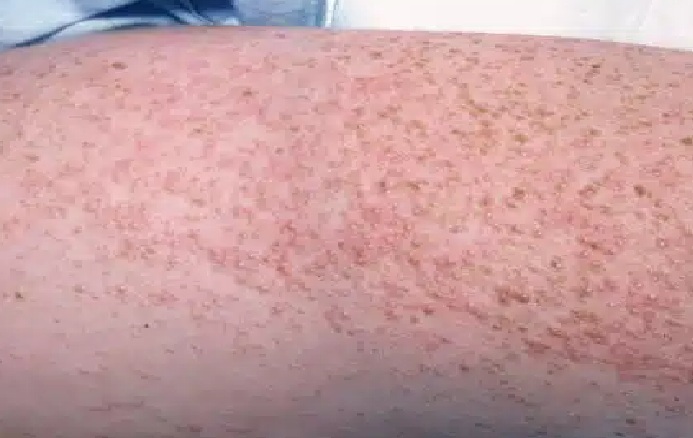Miliaria
Miliaria, also known as prickly heat, heat rash, or sweat rash, is a skin condition that occurs when sweat ducts become blocked, trapping sweat in the skin. Miliaria is a skin disease marked by small and itchy rashes. Miliaria is a common ailment in hot and humid conditions, such as in the tropics and during the summer season. Although it affects people of all ages, it is especially common in children and infants due to their underdeveloped sweat glands.

Miliaria is a cutaneous condition with retention of sweat due to obstructions of sweat ducts, rupture of occluded ducts, and extravasation of sweat at different levels in the skin.
Causes of Miliaria
Sweating is the most common risk factor, making hot or humid conditions and high fevers particularly associated with the development of miliaria.
Other causes of miliaria include
Occlusion of the skin
Transdermal drug patches and tight clothing have been associated with miliaria.
Type I pseudo hypoaldosteronism
This condition involves mineralocorticoid resistance, leading to sodium loss through eccrine glands, and has been associated with pustular miliaria rubra.
Strenuous physical activity
Intense exercise can contribute to the development of miliaria.
Morvan’s syndrome syndrome
A rare autosomal recessive disorder characterized by hyperhidrosis, among other abnormalities, which predisposes individuals to miliaria.
Medications
Drugs that induce sweating, such as bethanechol, clonidine, and neostigmine, have been associated with miliaria. Additionally, a few cases of isotretinoin-induced miliaria have been reported
Classification of Miliaria
Miliaria rubra (Prickly heat)
Miliaria – crystalline (Sudamina)
Sweat is retained sub corneally, causing clear, drop like vesicles that rupture with light pressure
Miliaria profunda
Sweat is retained in the dermis, causing papules that are larger and more deeply seated than those of miliaria rubra
Miliaria pustulosa
Post miliarial hypo hidrosis
Tropical anhidrotic asthenia
Occlusion miliaria
Colloid milium
Signs and symptoms of Miliaria
Small red rashes, called as papules, which may itch or more often cause an intense ‘pins-and-needles’ prickling sensation. These may simultaneously occur at a number of areas on a sufferer’s body, the most common including the face, neck, under the breasts and under the scrotum. Other areas include skin folds, areas of the body that may rub against clothing, such as the back, chest, and stomach, etc.
Treatment for Miliaria
As hot and sweaty conditions are primary risk factors for miliaria, managing the condition involves implementing general measures to reduce sweating and prevent eccrine duct blockage. This includes creating cooler environments, wearing breathable clothing, exfoliating the skin, removing skin-occluding objects such as bandages or patches, and addressing febrile illnesses.
Specific modalities for the treatment of miliaria are unique depending on the type. Miliaria crystallina usually does not require treatment, as it is self-limiting and typically resolves within 24 hours. Miliaria rubra is managed by reducing inflammation; thus, mild-to-mid-potency corticosteroids, such as 0.1% triamcinolone cream, may be applied to the affected areas for 1 to 2 weeks. If miliaria pustulosa develops, topical antibiotics such as clindamycin are used to address the superimposed bacterial infection.
Limited information exists on the treatment of miliaria profunda beyond the general measures previously mentioned. However, studies have indicated that miliaria profunda may improve with a combined regimen of oral isotretinoin (40 mg/d for 2 months) and topical anhydrous lanolin
Complications of Miliaria
1.Secondary bacterial infection Miliaria pustulosa or frank impetigo (tropical impetigo)
2.Anhidrotic asthenia if anhidrosis due to widespread Miliaria profunda
Prevention of Miliaria
- Avoid exposure to conditions of high heat and humidity
- Wear lightweight clothing
- Avoid exertion
- Use sunscreen
- Stay in air-conditioned buildings as much as possible
- Apply topical anhydrous lanolin before exercise
medlight2u.com
A light on Practice of Medicine (The information provided is for informational and educational purposes only and should not be considered professional advice)
- Sleeplessness (insomnia)
- Furuncle Nostril
- Presbyopia meaning “old eye”
- Oral cancer
- Gestational Trophoblastic Neoplasia (GTN)
Acne Acne vulgaris Acute Renal Failure Adrenal cortex Angina Angina Pectoris Aortic Regurgitation (AR) Aortic Stenosis (AS) Chest pain Chronic pyelonephritis Coarctation of Aorta Cough cyanosis Cystic acne Dehydration depression Diabetes Mellitus Diagnosis of Aortic Stenosis Dr.KTS DR K TAMILSELVAN Fatigue Heart Failure Hypertension Hypokalemia Hypothyroidism Ischemic Heart Disease LBBB Mitral Incompetence Mitral insufficiency Mitral valve prolapse Nocturia Patent Ductus Arteriosus PDA Polyuria Proteinuria pulmonary hypertension Pulmonary Stenosis ST Depression Symptoms of Acne Syncope Treatment for acne valvular heart disease Ventricular Septal Defect VSD Zits


Leave a Reply